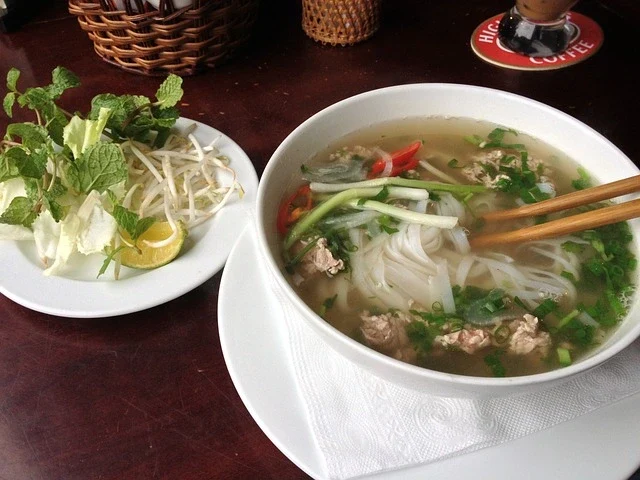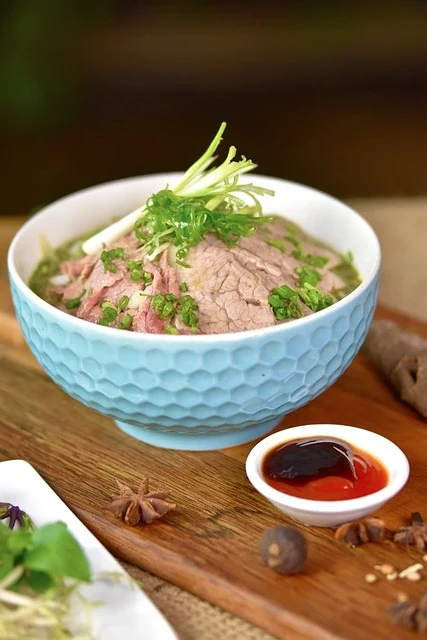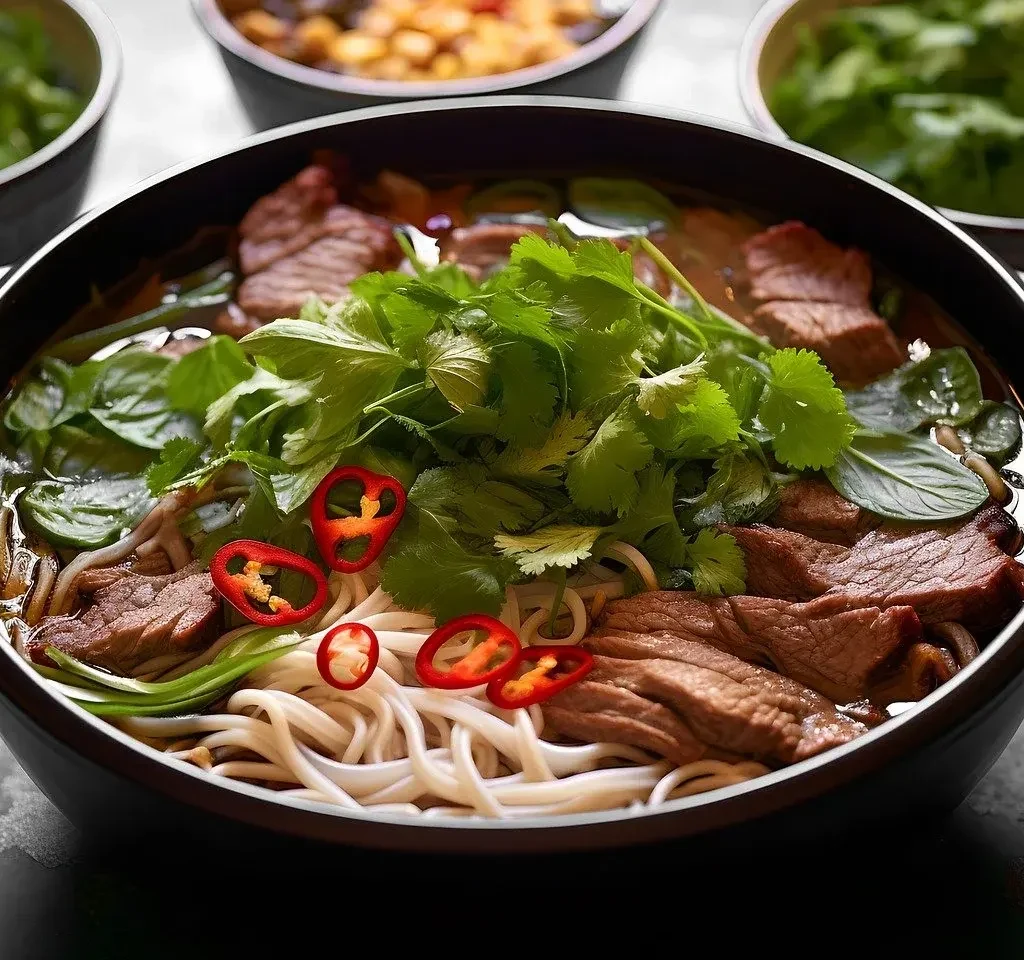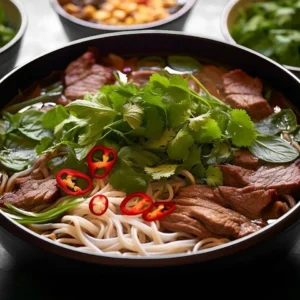Pho tai recipe features flat and soft rice noodles, a rich and flavorful broth, thinly sliced beef, fresh herbs, vegetables and sauces.

Pho is pronounced as “fuh”.
It is more than just a noodle soup. it’s a cultural icon. It is a symbol of Vietnamese cuisine that has captured hearts and stomachs around the world.
There are many variations of this beloved dish but Pho Tai stands out as a classic, a perfect balance of savory broth, tender beef, and fresh herbs.
The beauty of Pho Tai lies in its simplicity.
Thinly sliced raw beef, briefly submerged in a steaming, fragrant broth, cooks to tender perfection right before your eyes.
The plate of Pho Tai with fresh herbs and vegetables allows you to personalize each bite.
They add bursts of flavors and textures.
But don’t get fooled by basic and simple presentation of Pho Tai.
The depth of flavor in a good bowl of Pho Tai vietnamese dish is the result of hours of simmering, coaxing out the essence of beef bones, slightly burned onions, ginger, and a balance of spices.
It’s an effort and hardwork of love.
It is a testament to the Vietnamese gastronomic tradition that values the patience and attention to detail.
While the chances of recreating this iconic Pho Tai at home might seem near to impossible,
but fear not!
This recipe will guide you step-by-step through the process of the art of making Pho Tai and bringing the vibrant flavors of Vietnam to your own kitchen.
We’ll start by building a rich and flavorful broth, the foundation of our Pho Tai.

Then, we’ll move on to preparing the beef and assembling the perfect Pho Tai bowl, complete with all the traditional accompaniments.
So, are you ready to embark on this tasty and mouth watering adventure?
Tie on your apron, gather your ingredients, and let’s get started on creating a bowl of Pho Tai that will transport you to the bustling streets of Hanoi with every delicious slurp.
Why does Pho give me diarrhea?
- If the ingredients in the pho, particularly the meat or broth, were contaminated with bacteria or parasites, it could lead to food poisoning and cause diarrhea. This is more likely to occur if the pho was not prepared hygienically or if it was left out at room temperature for too long.
- Some people may be sensitive to specific ingredients commonly found in pho, such as:
- MSG: This flavor enhancer can cause digestive issues in some people.
- Spicy ingredients: Chili peppers and other spices can irritate the digestive system and lead to diarrhea.
- High-FODMAP vegetables: Some vegetables like onions and garlic are high in FODMAPs. These are the carbohydrates that can be difficult for some people to digest.
- Lactose intolerance:If you are lactose intolerant and the pho contains dairy products like condensed milk, it could trigger diarrhea.
- Other medical conditions: Underlying medical conditions like irritable bowel syndrome (IBS) or inflammatory bowel disease (IBD) can also make you more susceptible to diarrhea after eating certain foods, including pho.
It’s important to note that not everyone who eats pho will experience diarrhea.

If you consistently experience diarrhea after eating pho tai, it’s important to consult with a doctor to rule out any medical conditions and identify the specific cause of your symptoms.
Why is pho good for you?
Pho can be a nutritious and healthy meal It offers several potential benefits:
It is rich in protein. The broth is typically made by simmering meat bones for hours, which releases protein and other nutrients into the broth.
Additionally, pho usually contains meat, such as beef or chicken, further contributing to its protein content. Protein is essential for building and repairing tissues, and it can also help you feel full and satisfied after eating.
It is a source of vitamins and minerals. The broth and various ingredients in pho can provide essential vitamins and minerals, including:
- Vit B: These vitamins play a crucial role in metabolism and energy production.
- Iron: This mineral is important for red blood cell production and oxygen transport.
- Calcium and magnesium: These minerals are essential for bone health.
- Phosphorus: This mineral contributes to bone health and energy production.
The broth in pho is primarily water, making it a hydrating and comforting dish, especially beneficial when you’re feeling under the weather.

Some research suggests that the gelatin and collagen released from the bones during cooking may be beneficial for gut health.
When prepared with lean protein and without excessive noodles or fried toppings, pho can be a relatively low-calorie and low-fat meal.
However, it’s important to note that the nutritional value of pho can vary depending on the ingredients and preparation methods.
Some versions may be higher in sodium or fat, particularly if they include fatty cuts of meat or fried toppings.
Pho Tai Ingredients:
For the broth:
- 1.5 kg beef bones (preferably a mix of marrow bones and knuckle bones)
- 1 onion, halved
- 1 knob ginger, sliced
- 3 star anise
- 2 cloves
- 1 cinnamon stick
- 1 tsp coriander seeds
- 1 tsp fennel seeds
- 1 tbsp fish sauce
- 1 tbsp brown sugar
- 10 cups water
For the noodles and toppings of Pho Tai
- 400g dried flat rice noodles
- 300g beef thinly sliced
- 1/2 onion, thinly sliced
- 1 cup bean sprouts
- 1/2 cup Thai basil leaves
- 1/4 cup cilantro leaves
- Lime wedges, for serving
- Chili sauce, for serving
- Hoisin sauce, for serving
Instructions to prepare Vietnamese Pho Tai:
Prepare the broth:
- First boil the bones briefly in a pot of water for 5 minutes, then drain and rinse. This removes impurities and ensures a clearer broth.
- Simply grill or fry the onion and ginger halves until they are slightly burned. Trust me this would add a smoky flavor.
- Now place the blanched bones, charred onion and ginger, spices, fish sauce, brown sugar, and water in a large stockpot. Bring to a boil, then reduce heat and simmer for at least 1 hour.
- As the broth simmers, use a spoon to remove any fat that accumulates on the surface. This will result in a clear broth.
- Now after six hours strain the broth through a fine-mesh sieve into a clean pot. Discard the solids.
- You can adjust the taste and seasoning with additional fish sauce or salt if needed.

Prepare the noodles and toppings:
- Soak the rice noodles in warm water for 30 minutes. Drain and set aside.
- Freeze the beef for 30 minutes. Now cut this beef into thin slices. Freezing the beef makes it easier to achieve thin, even slices.
- Thinly slice the onion. Wash the bean sprouts and herbs, and cut lime wedges.
Assemble and serve the Pho Tai:
- Bring the broth to a simmer.
- Divide the softened rice noodles into serving bowls.
- Add the sliced beef to the bowls.
- Pour the hot broth over the noodles and beef.
- Briefly blanch the beef in the hot broth. This ensures the beef is cooked through while remaining tender.
- Top with sliced onions, bean sprouts, basil, and cilantro.
- Serve with lime wedges, chili sauce, and hoisin sauce on the side.
- Enjoy your delicious homemade Pho Tai vietnamese classic!
.
.

Pho Tai: Beef Noodle Soup Recipe
Ingredients
For the broth:
- 1.5 kg beef
- 1 onion halved
- 1 knob ginger sliced
- 3 star anise
- 2 cloves garlic
- 1 cinnamon stick
- 1 tsp coriander seeds
- 1 tsp fennel seeds
- 1 tsp fish sauce
- 1 tbsp brown sugar
- 10 cups water
For noodles and toppings:
- 400 g flat rice noodles dried
- 300 g beef thinly sliced
- ½ onion thinly sliced
- 1 cup bean sprouts
- ½ cup thai basil leaves
- ¼ cup cilantro leaves
- lime wedges for serving
- chili sauce for serving
- hoisin sauce for serving
Instructions
Prepare the broth:
- First, boil the bones briefly in a pot of water for 5 minutes, then drain and rinse. This removes impurities and ensures a clearer broth.
- Simply grill or fry the onion and ginger halves until they are slightly burned. Trust me this would add a smoky flavor.
- Now place the blanched bones, charred onion and ginger, spices, fish sauce, brown sugar, and water in a large stockpot. Bring to a boil, then reduce heat and simmer for at least 1 hour.
- As the broth simmers, use a spoon to remove any fat that accumulates on the surface. This will result in a clear broth.
- Now after six hours strain the broth through a fine-mesh sieve into a clean pot. Discard the solids.
- You can adjust the taste and seasoning with additional fish sauce or salt if needed.
Prepare noodles and toppings:
- Soak the rice noodles in warm water for 30 minutes. Drain and set aside.
- Freeze the beef for 30 minutes. Now cut this beef into thin slices. Freezing the beef makes it easier to achieve thin, even slices.
- Thinly slice the onion. Wash the bean sprouts and herbs, and cut lime wedges.
Assemble and serve:
- Bring the broth to a simmer.
- Divide the softened rice noodles into serving bowls.
- Add the sliced beef to the bowls.
- Pour the hot broth over the noodles and beef.
- Briefly blanch the beef in the hot broth. This ensures the beef is cooked through while remaining tender.
- Top with sliced onions, bean sprouts, basil, and cilantro.
- Serve with lime wedges, chili sauce, and hoisin sauce on the side.
.
.
How to say Pho?
The “ph” in pho is pronounced like the “f” sound in English. So, Pho is pronounced as “fuh”.

How to eat Pho?
- Prepare your bowl.
- Add any desired sauces or condiments like hoisin sauce, Sriracha, chili oil, or fish sauce.
- Squeeze in some lime juice for a tangy touch.
- Add fresh herbs like Thai basil, cilantro, and mint.
- If you like it spicy, add some sliced chili peppers.
- Use chopsticks to grab the noodles and place them in your spoon.
- Dip the meat in the hoisin sauce and chili sauce mixture.
- Slurp the noodles and broth together. It’s perfectly acceptable and encouraged to slurp.
- You can also use a spoon for broth.
- Feel free to add more sauces or herb as you wish.
Can you eat pho while pregnant?
Yes you can eat pho while pregnant, as long as the ingredients are fresh and the broth is hot and steaming. Here’s why:
- Rice noodles are a good source of carbohydrates and are safe for pregnant women.
- When the broth is hot and steaming, it ensures any bacteria are killed.
- If the meat is cooked thoroughly, it is safe to consume. Aim for well-done meat to be on the safe side.
- Vegetables in pho are typically fresh and provide essential vitamins and minerals.
Generally Pho is safe for pregnant women but you should check if the meat is not undercooked, herbs are properly washed and Pho is prepared in an hygienic environment.

Can you reheat pho?
Yes, you can definitely reheat pho. However, there are some things to keep in mind to ensure it retain its delicious flavor and texture:
- If your pho has noodles, it’s best to separate them from the broth before reheating. This prevents the noodles from becoming mushy and overcooked.
- Stovetop is the preferred method for reheating pho broth. Pour the broth into a pot and heat it over medium heat until it simmers. Do not let it boil, as this can affect the flavor.
- Briefly submerge the noodles in boiling water for a minute or two to warm them up.
- Once the broth and noodles are heated, simply combine them in a bowl and enjoy.
Final Words: Vietnamese Pho Tai Recipe
Here is your passport to a steaming bowl of authentic Pho Tai.
Ready to transport your taste buds straight to the vibrant streets of Vietnam.
With a little effort and these detailed instructions, you can recreate this iconic dish in your own kitchen, customizing it to your spice and flavor preferences.
So, ditch the takeout menus and get a flight to a culinary journey with this homemade Pho Tai recipe. I guarantee it will be a pho-bulous experience!

If you have hunger for more asian recipes like me Follow me on Instagram and Facebook for a daily dose of deliciousness, and don’t forget to leave a comment below with your Pho Tai experience!
Explore the rest of OnlyAsianFood for a treasure trove of authentic Asian recipes waiting to be discovered.
Happy cooking, and remember – the pho-tastic journey starts right here!


I have never ever tried eating pho in my life. After checking out your recipe I think I should try once. I have heard so much about this dish.